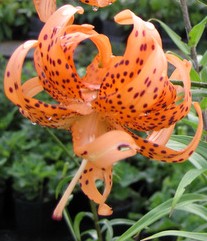
There are many good reasons to grow true lilies. They add height, fragrance, and elegance to the garden while being excellent cut flowers. Lilies go way back in history to 1600 BC, with the first ones, Lilium chalcedonicum, being seen in an ancient Minoan wall painting on the island of Crete. The Romans grew the Madonna lily (Lilium candidum), and painters in the Middle Ages included lilies in their religious pictures to symbolize the Virgin Mary. Many new lilies were brought to Europe in the 1800s and some of these were used to produce new hybrids in the 1900s. Bulb catalogues usually feature a large number of lilies but only a few a heirloom lilies.
Here are seven true heirloom lilies that can still be found in catalogues and from online sources, although some searching may be necessary.
 Madonna Lily (Lilium candidum)
Madonna Lily (Lilium candidum)
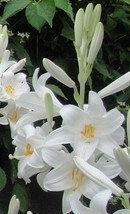 This ancient native of the Balkans and West Asia has tall stems each producing 5-10 trumpet-shaped fragrant flowers with white petals flushed with yellow at the base. Unlike most lilies the Madonna lily produces a basal rosette of leaves in the winter that dies back in the summer. They produce their bulbs near the surface of the soil so should be planted no more than one inch deep.
This ancient native of the Balkans and West Asia has tall stems each producing 5-10 trumpet-shaped fragrant flowers with white petals flushed with yellow at the base. Unlike most lilies the Madonna lily produces a basal rosette of leaves in the winter that dies back in the summer. They produce their bulbs near the surface of the soil so should be planted no more than one inch deep.
Type:
-
- Species
Height:
-
- 3-6’
Bloom Time:
-
- Mid-summer
Fragrance:
-
- Very strong
Hardiness:
- Zones 6-9
 Martagen Lily (Lilium martagon)
Martagen Lily (Lilium martagon)
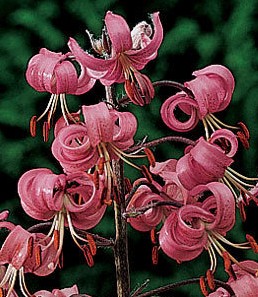 Known since 1568, this native of Europe and Asia is also called Turk’s cap. The fragrant flowers are white to pink and small but up to 50 may be found on a single stem. Plants resent being moved and may sulk for the first year. A cultivar introduced in 1601, L. martagon ‘Alba’, produces white flowers before the species.
Known since 1568, this native of Europe and Asia is also called Turk’s cap. The fragrant flowers are white to pink and small but up to 50 may be found on a single stem. Plants resent being moved and may sulk for the first year. A cultivar introduced in 1601, L. martagon ‘Alba’, produces white flowers before the species.
Type:
-
- Martegon
Height:
-
- 3-4’
Bloom Time:
-
- Early summer (
L. martagon ‘Alba’
-
- in very early summer)
Fragrance:
-
- Strong
Hardiness:
- Zones 3-7
 Regal Lily (Lilium regale)
Regal Lily (Lilium regale)
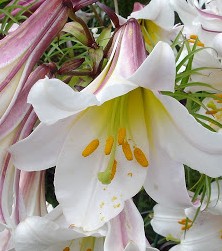 This native of western China was introduced into Europe about 1905. Regal lily has large trumpet-shape white flowers with a yellow throat and burgundy flush on the outside. Each stem bears up to 25 flowers. Very easy to grow, regal lily is a good back of the border plant but may need staking due to its heavy flowers. A variety, L. regale album, lacking the burgundy flush is also available.
This native of western China was introduced into Europe about 1905. Regal lily has large trumpet-shape white flowers with a yellow throat and burgundy flush on the outside. Each stem bears up to 25 flowers. Very easy to grow, regal lily is a good back of the border plant but may need staking due to its heavy flowers. A variety, L. regale album, lacking the burgundy flush is also available.
Type:
-
- Trumpet
Height:
-
- 3-6’
Bloom Time:
-
- Early summer
Fragrance:
-
- Very strong spicy
Hardiness:
- Zones 4-8
 American Turk’s Cap (Lilium superbum)
American Turk’s Cap (Lilium superbum)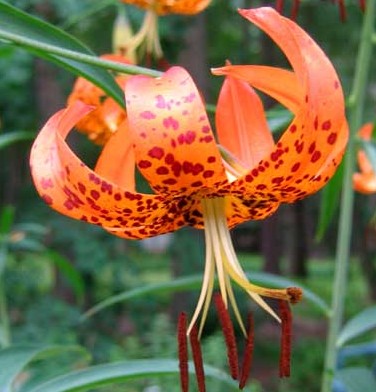 Discovered in 1865, this lily grows in moist, well-drained acid soils from Massachusetts to Indiana and Alabama. Each central stem bears 1-10 nodding flowers with orange petals and brownish purple dots.
Discovered in 1865, this lily grows in moist, well-drained acid soils from Massachusetts to Indiana and Alabama. Each central stem bears 1-10 nodding flowers with orange petals and brownish purple dots.
Type:
-
- Species
Height:
-
- 5-8’
Bloom Time:
-
- Mid-summer
Fragrance:
-
- None
Hardiness:
- Zones 4-8
 Tiger Lily (Lilium lancefolium; aka L. tigrinum ‘Splendens’)
Tiger Lily (Lilium lancefolium; aka L. tigrinum ‘Splendens’)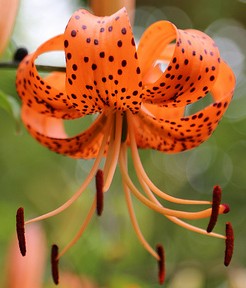 Introduced in 1804 this native of Asia features salmony-orange flowers with maroon-garnet spots. Bulbets form in the axis of the leaves leading to an increase in numbers. A double variety, L. lancifolium Flore-Pleno is also available.
Introduced in 1804 this native of Asia features salmony-orange flowers with maroon-garnet spots. Bulbets form in the axis of the leaves leading to an increase in numbers. A double variety, L. lancifolium Flore-Pleno is also available.
Type:
-
- Tiger
Height:
-
- 3-5’
Bloom Time:
-
- Mid summer
Fragrance:
-
- None
Hardiness:
- Zones 5-7
 Lilium auratum ‘Gold Band’
Lilium auratum ‘Gold Band’
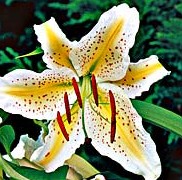 This native of Japan, introduced in 1862, became the rage in Victorian gardens and was prominent in John Singer Sargent’s famous painting Carnation, Lily, Lily, Rose. It has broad fragrant white flowers marked by prominent gold bands down the center and rust-red speckles.
This native of Japan, introduced in 1862, became the rage in Victorian gardens and was prominent in John Singer Sargent’s famous painting Carnation, Lily, Lily, Rose. It has broad fragrant white flowers marked by prominent gold bands down the center and rust-red speckles.
Type:
-
- Oriental
Height:
-
- 4-6’
Bloom Time:
-
- Mid summer
Fragrance:
-
- Very strong
Hardiness:
- Zones 5-7
 Henry’s Lily (Lilium henryi)
Henry’s Lily (Lilium henryi)
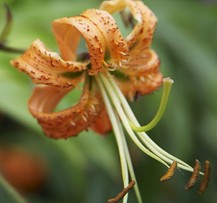 A native of central China and introduced in 1889, Henry’s lily is noted for its exceptionally long eyelash-like stamens that protrude well beyond the orange gold petals flecked with maroon. Ten to twenty flowers are produced on each stem.
A native of central China and introduced in 1889, Henry’s lily is noted for its exceptionally long eyelash-like stamens that protrude well beyond the orange gold petals flecked with maroon. Ten to twenty flowers are produced on each stem.
Type:
-
- Species
Height:
-
- 4-6
Bloom Time:
-
- Mid- to late summer
Hardiness:
- Zones 5-7
This list of heirloom lilies blooms from very early summer until late summer so by using them all you can have a spectacular display for most of the growing season. Most of these lilies are fairly tall and are suitable for the back of the border. Order bulbs in the summer and plant in the fall as soon as you receive them. Unlike tulips and narcissus, lily bulbs have a delicate covering and dry out quickly so prompt planting is very important.
